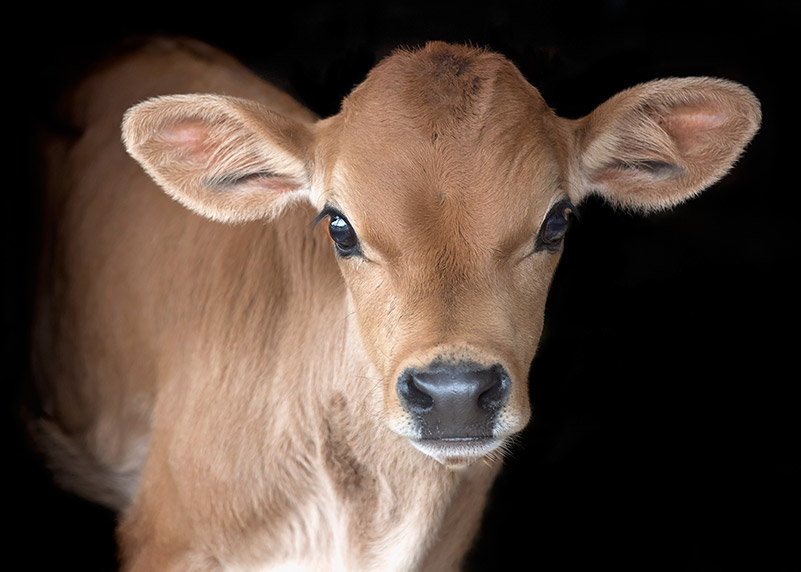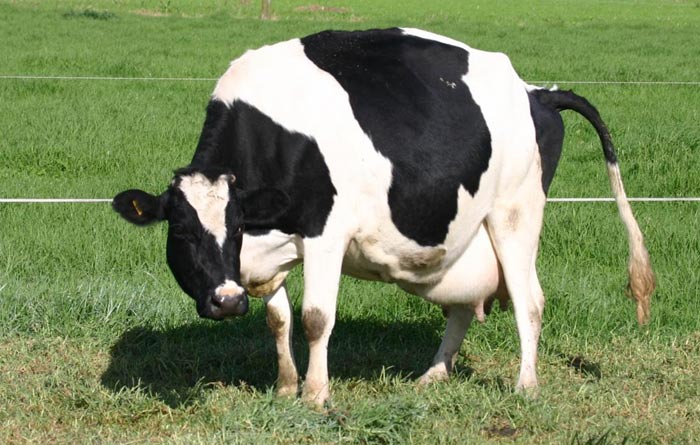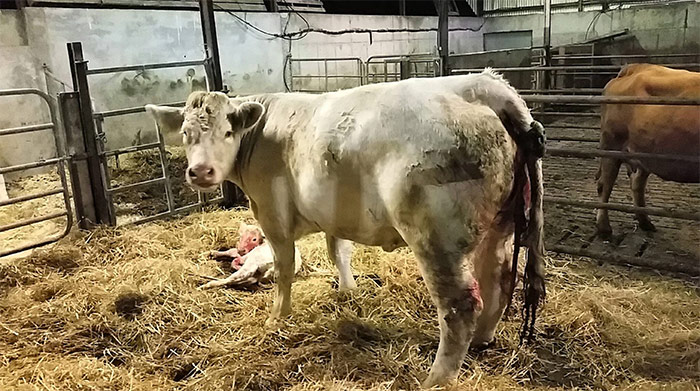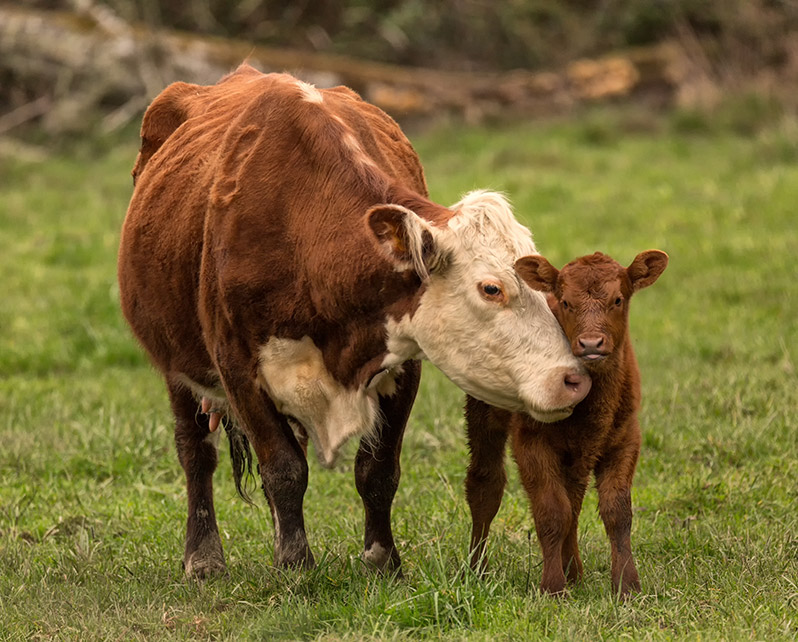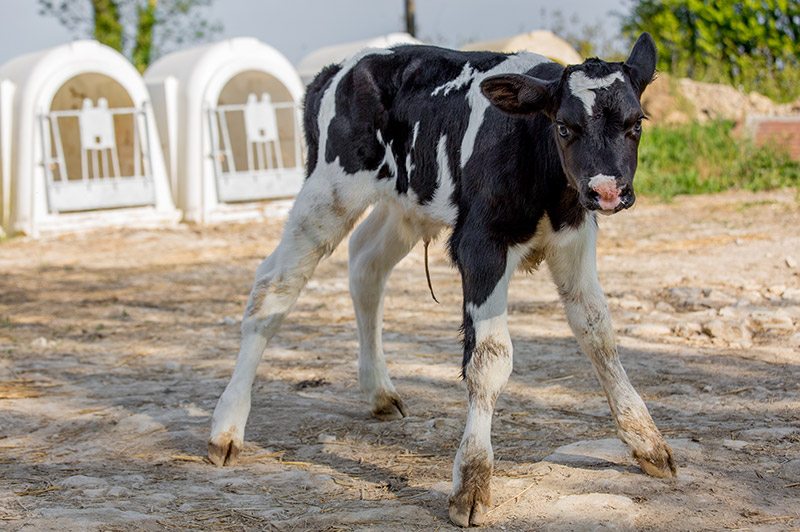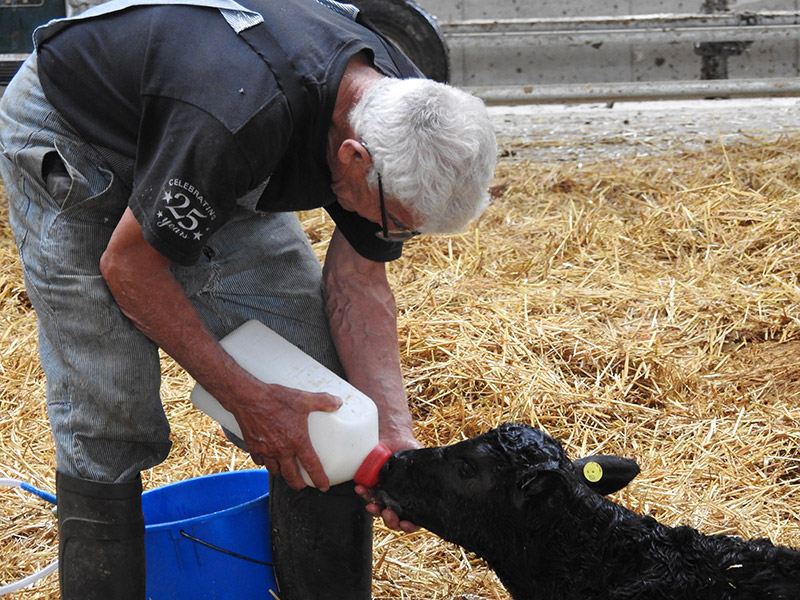Calf Management
Page 04 /
Newborn calf care is critical to the future success of your calves. There are several critical factors to take into account to prevent disease occurring early in life.
These critical factors include the management of:
Pregnant Cow Management
The management of pregnant cows, especially in the final weeks before calving, is a critical component of newborn calf health.
There are two major components that improve calf health:
- Vaccinations
- Nutrition
1. Vaccinations and Maternal Immunity
Vaccinating late gestation animals will help to bolster the antibodies she produces that are then deposited into colostrum for consumption by the calf. This is important because calves rely heavily on maternal immunity (the dam’s antibodies that were passed through the colostrum) until they begin to develop their own antibodies with subsequent exposure to pathogens. These maternal antibodies provide a protective effect for calves while their immune systems are developing.
There are many vaccines that are available to give to cows within the last 3-6 weeks prior to calving. These vaccines can help to protect against the most common diarrhea-causing pathogens, such as Escherichia coli, rotavirus, and coronavirus. It is important to consider the pathogens a calf may be exposed to early on, such as in the calving pen, or when nursing from the dam early. The chance of exposure to feces may be high, so providing calves with a protective response against these bacteria will be beneficial in preventing disease and subsequent antimicrobial use!
There are two key steps to remember here:
Step 1:
- Use a vaccine, in consultation with your herd health veterinarian, to boost the quality of the colostrum that your cows produce
Step 2:
- Develop and implement a protocol for exceptional colostrum management to ensure that the antibodies from the vaccine will be transferred
Talk to your veterinarian about the specific vaccination and colostrum management protocols that will work best on your farm!
2. Pregnant Cow Nutrition
Careful management of the ration that cows consume prior to calving is critical. There are consequences to both over- and under-feeding energy and other ration components.
Overfeeding:
Providing too much energy in the last trimester of pregnancy will lead to larger fetuses. The cow may become over conditioned, depositing fat into the pelvic area, which can cause calving complications when the amount of space available for the calf to come through the birth canal is limited or restricted.
Underfeeding:
Lower amounts of energy in the latter stages of pregnancy will lead to a smaller placental and fetal weight, as well as reduced growth and size particularly for first-time calvers. Mineral and vitamin imbalances, especially iodine and selenium deficiency, can contribute to high levels of mortality at birth.
Work with your nutritionist to have a well balanced ration to feed to your animals during the period prior to calving
Calving Management
There are many different factors to consider when calving starts including when and how to intervene to get the best outcome possible for the calf.
Calving occurs in 3 stages. Becoming familiar with the stages of labour can help to recognize how progression should be occurring, and can allow for more effective intervention:
-
Stage I:
-
Stage II:
-
Stage III:
When to Intervene?
Excellent supervision of cows that are close to calving is critical to ensure that intervention is applied at the appropriate time. The best time to apply an intervention is when cows are in labour for more than 70 minutes after the feet or amniotic sac appears at the vulva. However, many times, it is difficult to identify the exact time when the feet appear. Therefore, an examination of the situation is necessary when the calving cow is first identified.
Specifically, an intervention should be applied at first examination if:
- There is brown, red, or foul smelling fluid
- Tongue, feet, or head are swollen or cold
- The calf is not coming through the birth canal normally
- There are twins present
If everything is normal at the first exam, continue monitoring for progress to ensure that it is occurring every 30 minutes. If no progress occurs, an intervention should be applied.
How to Intervene?
Ensuring that the calf is in the right position and that there is sufficient dilation of the birth canal are the first keys to a successful intervention. Other important practices to consider are:
Cleanliness:
Clean the vulva with soap to prevent bacteria from entering the uterus that can increase the risk of an infection (metritis).
Lubrication:
There is no such thing as too much lubricant!
Traction:
Don’t apply too much force! This can lead to serious injuries to both the cow and the calf. Only one person should be pulling with a rope (looped in two places around the fetlock) and ensure when using a calf jack, that there is not too much force applied.
Work with your veterinarian to develop a calving protocol to minimize the challenges that arise due to the calving process. This should include consideration about pain management, as providing a non-steroidal anti-inflammatory drug after a difficult calving can help to improve both cow and calf performance
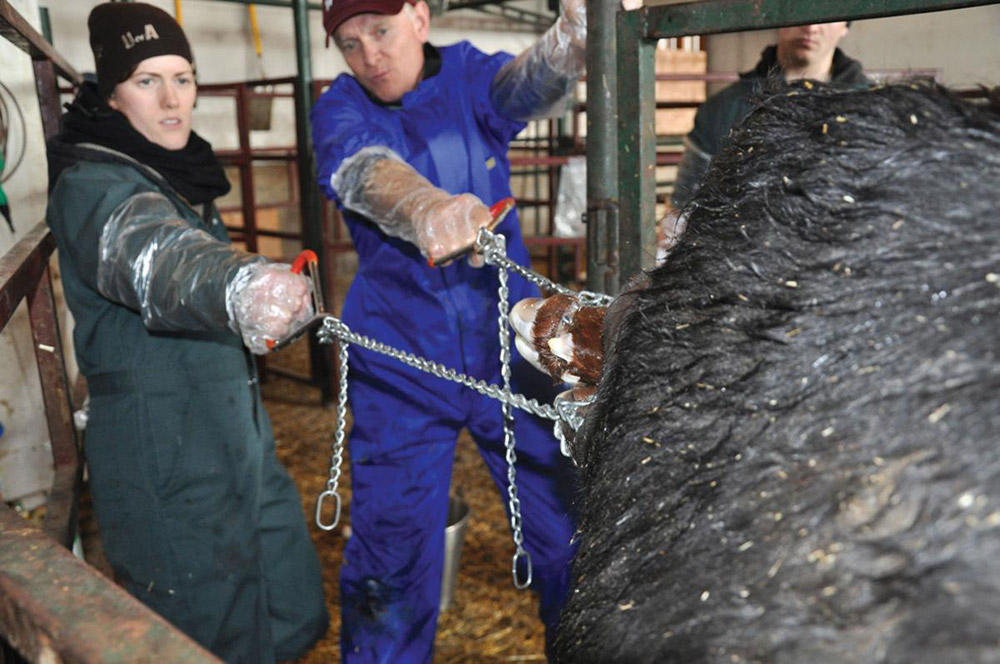
Source: Western Livestock Journal
Colostrum Management
There are no management practices more important than providing colostrum to newborn calves. Calves are born without an actively functioning immune system and rely on the absorption of immunoglobulins from colostrum from the dam to protect them against disease early in their lives.
Dairy Calves
For more information on colostrum management in dairy calves, check out Why is Colostrum Management So Important? within the Antimicrobial Stewardship in the Ontario Dairy Industry FAAST Review. These practices apply for both male and female dairy calves. Doing so ensures future dairy replacements are set up for success, and male dairy calves that are destined for veal or beef can also thrive.
The Canadian dairy industry requires as part of their quality assurance program, proAction®, that sufficient quantity of good quality colostrum is provided to both male and female calves, and must be outlined in a standard operating procedure (SOP).
Beef Calves
Although many of the principles of colostrum management are the same in beef and dairy calves (i.e. ensuring a sufficient quantity of high quality colostrum is provided quickly to the calf), there are some significant differences.
For example, the calf must:
- Stand, walk, find the dam’s teat
- Suckle while the dam is standing
The cow must:
- Produce an adequate amount of colostrum with a high level of immunoglobulins
- Have teats that can be grasped by the calf
Clearly, there many unique barriers to colostrum management for beef calves, however these can be overcome through several management techniques:
Breeding
- To ensure that a vigorous calf is born ready to suckle, it is important to ensure that the calf will not experience a difficult calving. Selecting a sire to produce an appropriately sized calf to avoid a difficult calving is critical
- Another consideration at breeding time is whether the cow’s teat conformation is appropriate. The teat conformation at the time of calving is important as it will influence whether a calf is able to suckle colostrum effectively. If the teat conformation is poor, this should be recorded and the cow should not be rebred!
Calving management
- Calves born from a difficult calving will take longer to stand and to successfully suckle. The cow will also have a poorer cow-calf bond. Ensuring that all precautions are taken to minimize the risk of a difficult calving through breeding decisions, supervision of cows close to calving, and intervening at the right time will improve the ability of young beef calves to consume enough colostrum
Close supervision of the newborn calf
- It is imperative to ensure that the calf consumes colostrum quickly after birth. Check in on the calf within the first few hours after birth to ensure it has had its first meal (particularly when calving on pasture in the cold weather of early spring), or to help the calf get attached to the cow’s teat. It can be difficult to know if the calf drank from the cow, but look for signs like a slack udder in the dam, sunken flank in the calf, or lack of suckle reflex in the calf. If you are having trouble getting the calf attached to the cow, try feeding a colostrum replacer or stored colostrum to feed the calf. Beef calves should get 2 L of colostrum if they do not appear to have suckled from the dam within 6 hours of birth
The recommendations for colostrum feeding for beef calves are outlined in the National Farm Animal Care Council’s Code of Practice for the Care and Handling of Beef Cattle.
Beef producers may benefit from developing a protocol, in consultation with their veterinarian, for monitoring colostrum intake in newborn calves and supplementation for calves that did not suckle immediately after birth
Housing and Feeding Equipment Cleanliness
Cleanliness is a critical component of newborn calf management. Calves are very susceptible to infections in early life, which is why it is critical that management practices are in place to minimize contact with pathogens to prevent disease.
Housing
- Calving environment: This is the first area that calves come into contact with. Ensuring that the area is clean, free of manure, and well bedded can go a long way to help mitigate the entry of bacteria or other pathogens into the calf through its mouth or umbilicus
- Calf housing after birth: Whether the calves are housed with their dam on pasture, or indoors in a group pen, it is important to ensure that manure buildup is minimal. Older calves and cows can serve as sources of pathogens through their manure, so ensuring a clean environment can prevent future disease
Feeding Equipment
This is more of an important factor for dairy and veal calves, however, feeding equipment can be a significant source of bacterial contamination for any calf.
Ensure that they are cleaned well, which means:
- Initial rinse with warm water
- Soak in hot water with detergent
- Scrub with soap and brush
- Rinse with hot water
- Let dry
Nutrition
Ample nutrition is critical to ensure that the calf has enough resources to grow, thermoregulate (warm and cool their body), fight infection, and have a good immune response. For dairy calves, this is defined as providing 8-12 L of milk daily, whereas, for beef calves, it is ensuring that calves are suckling well from their dam. Proper nutrition of calves helps to protect against disease and improves growth. Work with your veterinarian and nutritionist to ensure your calves are getting the energy they need to thrive!
Whether you work with beef or dairy calves, be sure to use a gradual weaning process (e.g. step-down over 1-2 weeks in dairy, using fenceline weaning or QuietWean devices in beef) and ensure calves are consuming sufficient starter or grain before completely removing access to liquid feed. For more information, visit our FAAST Review, Antimicrobial Stewardship in the Ontario Beef Industry, including the section Weaning Practices.
Take Home Messages
- Management of calves starts even before calves are born with providing pregnant cows with a well-balanced ration
- When calving occurs, it is important to intervene appropriately if required with the correct strategy to prevent the consequences that can occur due to a difficult calving
- Following calving, ensuring that colostrum is consumed quickly after birth in sufficient quantity will lead to a healthy calf when combined with ample nutrition
- Work with your veterinarian and other advisors to ensure the management of your newborn calves will set them up for success
